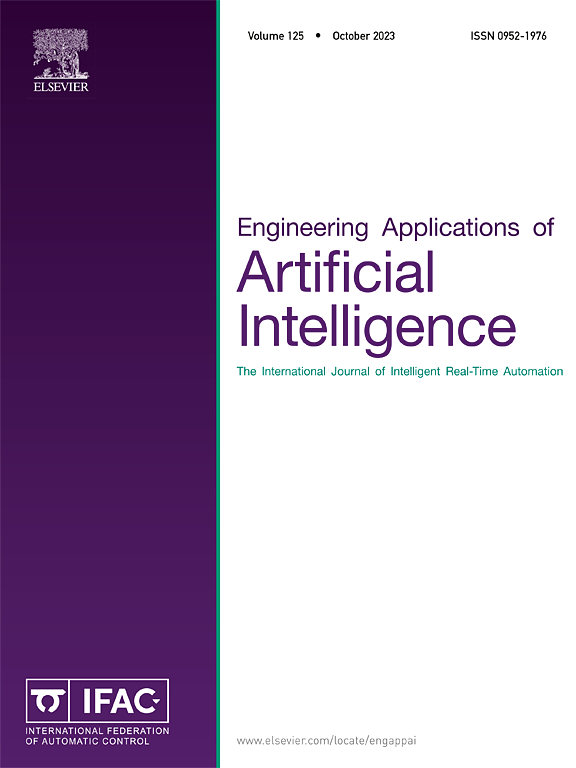一种用于路面日常维修监测的自定义多级损伤分割方法
IF 7.5
2区 计算机科学
Q1 AUTOMATION & CONTROL SYSTEMS
Engineering Applications of Artificial Intelligence
Pub Date : 2025-05-01
DOI:10.1016/j.engappai.2025.111002
引用次数: 0
摘要
本研究探讨了智能检测方法在监测城市道路沥青路面维修质量方面的有效性,并重点解决了识别重叠目标像素和区分细尺度破损和大尺度块补丁的挑战,这些任务严重依赖于空间语义。构建了包含13个类和5633个标签的分割数据集。构建并评价了Deeplab V3+、SCTNet (Single-Branch Convolutional Neural Network with Transformer semantic Information)、FastFCN (Fast Fully Convolutional Network)、MobileNet V3和SegNext 5个语义分割模型。尽管SCTNet的尺寸相对较小,但其处理速度最高,而MobileNetV3的尺寸最小,精度最低。SegNeXt模型在分割精度和模型复杂度方面均表现出优异的性能,被选为基准模型。研究了路面分类作为背景、采用多尺度输入和积分加权损失函数三种训练策略。结合了所有三种策略的模型(称为SegNeXt_IPWM)展示了最有希望的结果。与基线模型相比,SegNeXt_IPWM取得了显著的增强,mIoU(平均路口超过Union)增加了2.08%,平均f分数提高了1.42%。除标记丢失外,在所有类别中都观察到显着的改进,特别是在松散(+ 7.75% IoU),块补丁(+ 6.62% IoU)和线性裂纹(+ 4.87% IoU)检测方面取得了显著进展。此外,SegNeXt_IPWM展示了卓越的泛化能力,特别是在涉及背景目标干扰的情况下,强调了其在应用中具有强大性能的潜力。本文章由计算机程序翻译,如有差异,请以英文原文为准。
A customized multi-class pavement distress segmentation method for routine repair monitoring
This study investigates the efficacy of intelligent detection methods for monitoring the quality of urban road asphalt pavement repairs, and focuses on addressing the challenges of identifying overlapping target pixels and differentiating between fine-scale distress and large-scale block patches, tasks that heavily rely on spatial semantics. A segmentation dataset comprising 13 classes and 5633 labels was constructed. Five semantic segmentation models including Deeplab V3+, SCTNet (Single-Branch Convolutional Neural Network with Transformer Semantic Information), FastFCN (Fast Fully Convolutional Network), MobileNet V3, and SegNext were constructed and evaluated. Despite its relatively smaller size, SCTNet exhibited the highest processing speed, while MobileNetV3 exhibited the smallest size and lowest accuracy. The SegNeXt model demonstrated superior performance in both segmentation accuracy and model complexity, making it chosen as the baseline model. Three training strategies were explored: classifying pavement as background, employing multiscale input, and integrating a weighted loss function. The model that combined all three strategies (referred to as SegNeXt_IPWM) demonstrated the most promising results. Compared to the baseline model, SegNeXt_IPWM achieved significant enhancements, with a 2.08 % increase in mIoU (mean Intersection over Union) and a 1.42 % improvement in mean F-score. Notable improvements were observed across all categories except for marking loss, with particularly substantial gains in loose (+7.75 % IoU), block patch (+6.62 % IoU), and linear crack (+4.87 % IoU) detection. Additionally, SegNeXt_IPWM demonstrated superior generalization capabilities, especially in scenarios involving background target interference, underscoring its potential for robust performance in applications.
求助全文
通过发布文献求助,成功后即可免费获取论文全文。
去求助
来源期刊

Engineering Applications of Artificial Intelligence
工程技术-工程:电子与电气
CiteScore
9.60
自引率
10.00%
发文量
505
审稿时长
68 days
期刊介绍:
Artificial Intelligence (AI) is pivotal in driving the fourth industrial revolution, witnessing remarkable advancements across various machine learning methodologies. AI techniques have become indispensable tools for practicing engineers, enabling them to tackle previously insurmountable challenges. Engineering Applications of Artificial Intelligence serves as a global platform for the swift dissemination of research elucidating the practical application of AI methods across all engineering disciplines. Submitted papers are expected to present novel aspects of AI utilized in real-world engineering applications, validated using publicly available datasets to ensure the replicability of research outcomes. Join us in exploring the transformative potential of AI in engineering.
 求助内容:
求助内容: 应助结果提醒方式:
应助结果提醒方式:


